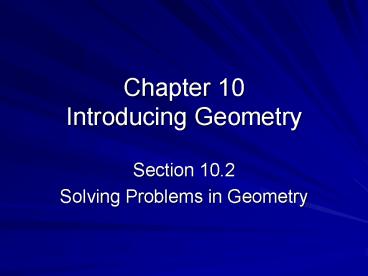Chapter 10 Introducing Geometry - PowerPoint PPT Presentation
1 / 23
Title:
Chapter 10 Introducing Geometry
Description:
Points and lines are basic building blocks for other geometric ideas ... In every triangle, the centroid, the orthocenter, and the circimcenter are collinear. ... – PowerPoint PPT presentation
Number of Views:86
Avg rating:3.0/5.0
Title: Chapter 10 Introducing Geometry
1
Chapter 10Introducing Geometry
- Section 10.2
- Solving Problems in Geometry
2
Review of Basic Geometric Terms
- In small groups, complete the Mini-Investigation
10.2 on page 534 of your textbook. - Be sure to use appropriate symbols when naming
each.
3
(No Transcript)
4
Point and Line Problems
- Points and lines are basic building blocks for
other geometric ideas and relationships. - Network (graph) theory is very useful for solving
some types of real-world problems.
5
Vocabulary of Networks
- Vertices points of intersection
- Edges segments or arcs
- Network total configuration of vertices and
edges - Traversable Network paths of network can be
traced only once without lifting pencil from
paper - Traversable Type 1 beginning and ending point
is same - Traversable Type 2 beginning and ending points
do not coincide - Odd Vertex odd number of edges meet at vertex
- Even Vertex even number of edges meet at vertex
6
Network Traversability Theorem
- If a network has all even vertices, it is
traversable type 1, and the traversable path may
begin at any vertex. - If a network has exactly two odd vertices, it is
traversable type 2, and the traversable path must
begin at one of the odd vertices and end at the
other. - If a network has more than two odd vertices, it
is not traversable.
7
Example
- Do Exercise 14 on page 545.
8
Example
- Do Exercise 48 on page 549.
9
Review of Ideas about Segments, Angles, and
Triangles
- In small groups, complete the Mini-Investigation
on page 537 of your textbook. - Be sure to use appropriate symbols when naming
each.
10
(No Transcript)
11
Triangle Concurrency Activity
- Using the sheet of triangles provided in class,
cut out each triangle carefully. - We will use each triangle to fold segments that
will represent the following segments in a
triangle - Median
- Altitude
- Perpendicular Bisectors
- Angle Bisectors
12
Median of a Triangle
- A median of a triangle is a segment that extends
from the vertex of an angle to the midpoint of
the opposite side.
13
Concurrency Relationships in Triangles
- The three medians are concurrent at a point
called the centroid, which is the balance point
or center of gravity, of the triangle. The
centroid is two-thirds the distance from each
vertex to the opposite side.
14
Altitude of a Triangle
- An altitude of a triangle is a segment that
extends from the vertex of an angle and is
perpendicular to the opposite side.
15
Concurrency Relationships in Triangles
- The three altitudes are concurrent called the
orthocenter.
16
Perpendicular Bisector of a Triangle
- A perpendicular bisector of a triangle is a
segment (or line) that is perpendicular to each
side at its midpoint.
17
Concurrency Relationships in Triangles
- The three perpendicular bisectors of the sides
are concurrent at a point called the
circumcenter, which is the center of a circle
containing the vertices. We say that this circle
circumscribes the triangle and that the triangle
is inscribed in the circle.
18
Angle Bisector of a Triangle
- An angle bisector of a triangle is a segment that
bisects each angle at its vertex and extends to
the opposite side.
19
Concurrency Relationships in Triangles
- The three angle bisectors are concurrent in a
point called the incenter, which is the center of
a circle that is tangent to each side of the
triangle. We say that this circle is inscribed
in the triangle.
20
The Euler Line
- In every triangle, the centroid, the orthocenter,
and the circimcenter are collinear.
21
An Application to Earthquakes
- During a recent earthquake in the western United
States, three cities recorded identical measures
of intensity from seismographic readings taken at
the same time. Since the seismographic readings
were the same, each city was the same distance
from the epicenter of the earthquake. - How could the epicenter of the earthquake be
determined using this information?
22
Earthquake Extension Activity
- Since seismographic readings are seldom the same
from city to city, seismologists use circles to
pinpoint the location of the epicenter of an
earthquake. - Readings from cities are taken and an epicentral
distance from the readings are used as a radius
of a circle that is constructed around each city. - The intersection of the circles pinpoints the
location of the earthquakes epicenter.
23
Earthquake Extension Activity
- Students can learn how actual seismologists
determine the epicenter and intensity of an
earthquake by visiting a Virtual Earthquake site
and doing an online activity. - Web Address http//sciencecourseware.com/Virtual
Earthquake/































